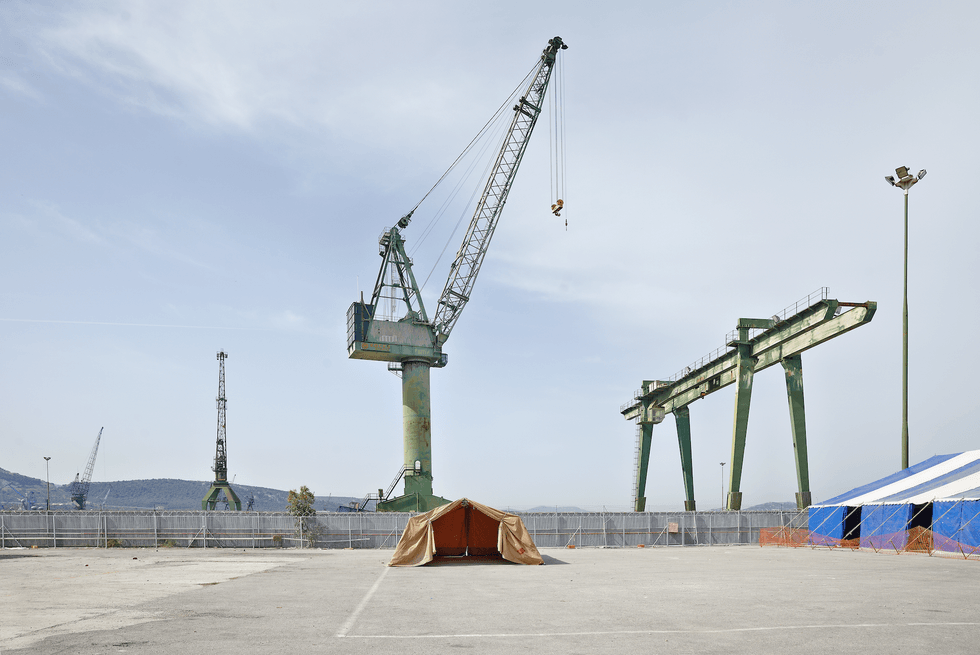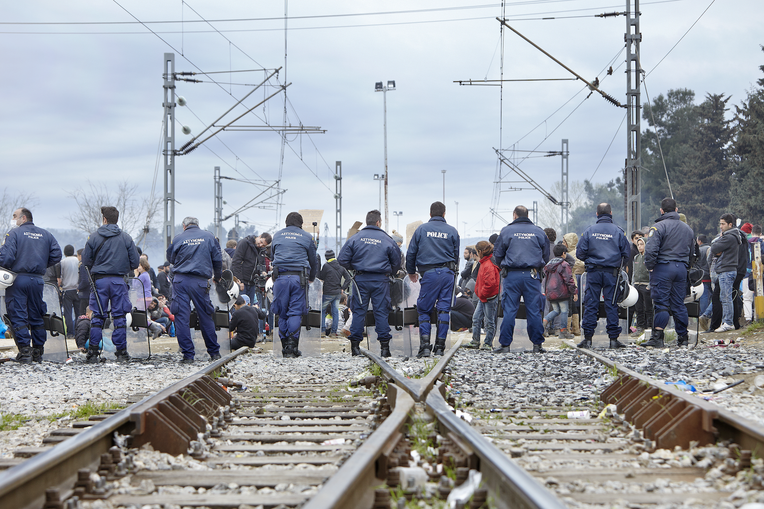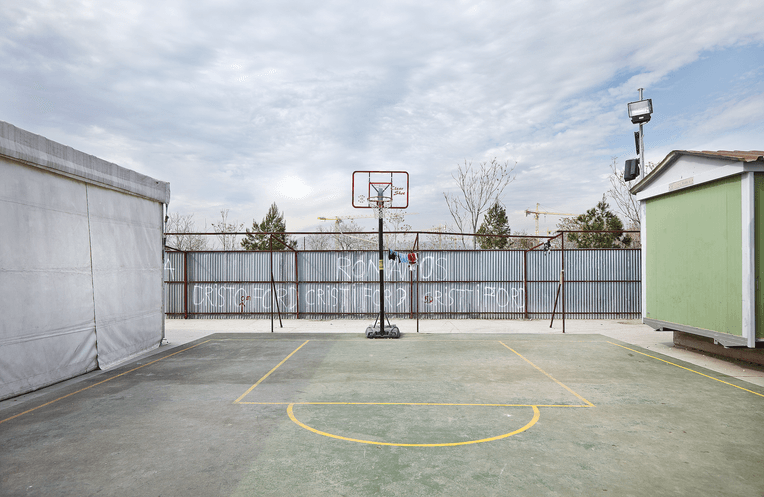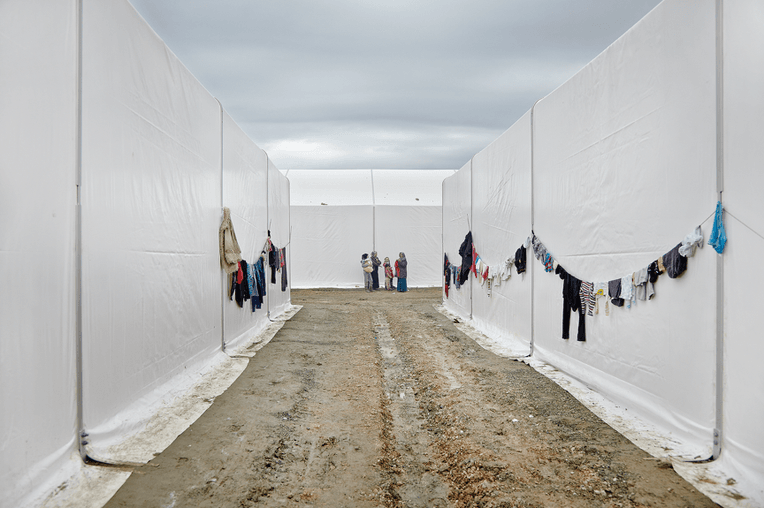
My grandmother had very few photographs from her childhood; I believe there were only two.1 The first photo was one taken in an unknown studio, depicting her entire family. Being the youngest of her siblings, she still was a pupil whilst her oldest brother was a young man. The other one was a tiny photo—taken not too long before or after the family photo—in which she is again a young girl, wearing a dirty dress, standing in a ground of dry mud next to a dusty tent. On the background one could also see some derelict and probably abandoned machinery, perhaps a testimony to the economic catastrophe of Greece after a decade of wars. That tent was located in a refugee camp in a salt field on the south coast of Attica. Her entire family stayed in this refugee camp for several years together with other refugees who were displaced to Greece from Turkey after the Greek-Turkish war of 1922. From the area of Istanbul where the family lived, they first reached Lesbos Island, where they stayed for a while, then Piraeus, where they stayed again for a short period. At the end, they were moved into the refugee camp in the salt field of Anavyssos, where the photo was taken. Eventually, after some years a small village was built with the aid of the Greek state authorities and became their new home. This is a rather lasting experience as Anavyssos did not exist before as a settlement and still people who originate from these first residents of the village, including my family, self-identify as “refugees,” like many Greek citizens who originate from the almost one million refugees of that war (see Hirschon 1995). As a child this photograph made me sad; first, the small girl looked very unhappy. Second, when I was asking my grandmother to show me more photos from her childhood, her answer was that she does not have any. Being a child of the 1980s with my own photo album, I used to find that lack of visual representations of several decades of her life striking. These non-existent items in my mind were a testimony of the difficulties she went through when she was a child herself. Later when I was trained to develop films and photos, I realized the difficult logistics of taking photos in a refugee camp of the 1920s that was located in what is basically a marsh, sixty kilometers away from Athens.
Although, the refugee crisis of 2015 happened almost a century later, the trajectory was very similar, namely from Turkey to Lesbos and other Eastern Aegean islands to Piraeus and from there to the Greek inland or to the borders. More strikingly, seeing the refugee camps, the image of my grandmother in front of the tent kept coming into my mind. Yet we are in a very different era where one could claim that the contemporary refugee crisis is probably over-represented visually.
On the Ethics of the Visual
As Guy Debord (1992) had suggested within the political economy of the spectacle, the moving—and sometimes the still—image becomes the temporarily reproduced fetish that hides the actual historical and hierarchic relationships that led to the production of the events that are captured by the camera and broadcast through media. Berger (1980), took the ethical questions of the image further, suggesting that the visual aestheticization of destitution and misery could potentially glorify what it wants to disavow implying that the visual over-exposure to human misery essentially anaestheticize the viewers (see Kalantzis 2016). Today, at the age of the digital and visual hyper-plethora—where every cellphone is a camera and potentially a broadcaster of images—the ethical challenges of the visual representation are more urgent than ever before. Within the professional industry of mass media and the amateur/semi-professional industry of social media, images of human tragedy, death and fear are predominant and they become commodities in an overheated political economy of clicks.2And yet, in spite of all these issues that occur when someone deals with images, the image succeeds in communicating different forms of information than text, multiplying the potentialities and the capacities of the anthropological project—as Yalouri (2016) and Konstantinos Kalantzis (2015) suggest, in reference to the crisis in Greece specifically.
Moreover, there is another more explicitly political dimension in the anthropological involvement with the image: this very same relationship between image, corporate mass media, and the political interests they serve implicitly or explicitly. Reports on the media coverage of the 2015 refugee crisis show overwhelmingly that the majority of the European corporate mass media reproduced systematically unfair and imprecise discourses regarding the refugees of 2015 (Berry, Garcia-Blanco, and Moore 2015; Greussing and Boomgaarden 2017; Georgiou and Zaborowski 2017). Corporate mass media and the images they used contributed to the elevation of the refugee and migratory flows into an emergency, shifting the attention from the humanitarian or contextual aspects to the supposed security and economic threat questions. Definitely, within this ethically questionable practice, the role of the professional images that were broadcast by mass media cannot be underestimated into the social legitimization of “Fortress Europe” (Carr 2015).
These issues preoccupied many of the debates Yannis Zindrilis as photographer and I as ethnographer (with occasional visual engagements) have had off and on over the last ten years working and sometimes being politically active together. Being based (fully or partly) in Greece, being involved in grassroot politics in solidarity with the refugees, witnessing the camps and the ongoing crime called Fortress Europe, we faced a set off dilemmas: What about the problem of documentation and memory? Namely, how do you document crimes such as nation-state borders and their victims in the twenty-first century? How can we contribute—visually and textually—to discourses that are antithetical to the predominant ones which portray the refugees as a threat, as “invaders” and “dangerous” as “enemies”? And how can we deal with the spectacular dimensions of the image?
Within that context, acknowledging the advantages, the limitations, and the potential dangers that the spectacle may carry, our selected medium towards—an admittedly small—contribution to these other discourses is the current photo essay. The photo essay speaks primarily the popular language of professional photography that is used by the mass media. Yet the information that our images and the text communicate together is different than the predominant one, as it provides a framework that we aim to be radically different from the existing ones. Crystalizing more than fifteen years of ethnographic research in several borders and cityscapes of the Mediterranean and fifteen years of visual documentation of contemporary Greece we aim to frame the refugee crisis in terms of its materiality. Building on the access we had to refugee camps, we aim to embed the refugee materiality—the camp—within the material context of the European economic and political crisis: the ruins. Mainly the ruins of the economic boom of 1990s–2000s that paved the way for the Greek version of the European economic crisis. By making explicit the relationship between ruins and camps we aim to provide an exegesis of the “refugee crisis” as simply an expression of the European political/economic crisis. We suggest that through a systematic implementation of a visual and textual language of emergency and danger for Europe, supposedly due to the refugee crisis, within their political and media discourses, the European elites are trying to win time from the systemic failure of the European neoliberal project. Although these thoughts have been expressed before (Dalakoglou 2016a), the visible coexistence of the camps and the ruins shouts loudly the connection between the European political crisis and the attempts to translate it into an imagined “refugee crisis.”
Camps and Ruins
So, what is the precise relationship between these two types of materiality, the camps and the ruins? Following the end of the Cold War there were two spatio-material conditions that became the infrastructures of new Europe. The first one was the new geopolitical condition signified by a privileged European geographic spatiality and a common border of the European Union that would gradually expand to incorporate the East European neophytes of capitalism into the West: Fortress Europe. The second spatio-material condition of the end of the Cold War was the one that always follows wars. Namely, the winners occupy and take control over the territories of the defeated. In this case, the capitalist system took control over all the public- and cooperative-owned real estate and privatized most of it in both Eastern and Western Europe.3
The recently “united” continent had to also build the connective infrastructures that would—both literally and figuratively—concretize the unity and the links across what was previously the Iron Curtain. Trans-European and Inter-European corridors: motorways, railways, pipelines, cables, and energy grids crossed the old border with newfound force.
The change in the form of governance of spaces meant the injection of a huge resource—real estate—to the European capitalist system. Moreover, the economic boom was assisted by the sudden mass influx of inexpensive Eastern European labor following the collapse of socialist economies.
Both public and private building projects in the east and the west of Europe blossomed, with construction (together with finance) becoming the steam engine of the Greek and to a great extent the European economy, promoted by Euro-zone integration policies that “liberated” the financial sector leading to the influx of debt and the financialization of real estate.
Thus, following the end of socialism the continent saw one of the largest construction projects in its recent history, second only to the post–World War II reconstruction. Three Olympic games and the creative destruction (Harvey 2007) of their respective European metropolises (Barcelona, Athens, London), along with several other mega-events, played crucial roles in the boom that started in the 1990s and culminated in the stagnation of the late 2000s.
However, if the two spatio-material pillars of post–Cold War Europe were the mass (re)construction of the European built environment and a new mobility/border condition, then the Euro-crisis is precisely the radical deceleration of the first one. The European construction index was in free fall between 2008 and 2014 and has never properly recovered. More and more commentators talk about the infrastructural crisis, projecting Europe to be the continent that will suffer the most due to that crisis (see Dalakoglou 2016b). The European dream of eternal economic growth, increase in private wealth, bottomless debt and spending power, and a state apparatus as private welfare provider is collapsing for the majority of younger-generation Europeans.
So, what remains for the European state apparatuses to create consent within the European societies? The borders and the privileged geographic identification. Refugees are the new deus ex machina who came to save Europe from its own systemic crisis (see Nanopoulos and Vergis 2019), as the EU state members will no longer deliver the welfare and other promises that were provided to their citizens in the decades before the 2008 crisis. European state apparatuses—which annihilated their social policies and having in fact lost control of their economies and their legitimization to govern—suddenly see the biopolitical control of refugee populations as the unique opportunity to show their force and capacities to govern a “profound” emergency: the so-called refugee crisis. Thus, the richest continent in the world labeled the one million refugee influx (over a two-year period) as an emergency that requires exceptional measures and policies of all descriptions. Therefore, refugees are stockpiled into camps in the entry country, they are slowly having their data recorded, and they are gradually filtered in multiple ways before they are deported or allocated to the right destination. Meanwhile, refugees’ rights to safety and basic human rights—even their right to life— are neglected in the name of rescuing the pride of failing state apparatuses. Yet the ruins and semi-ruins of the boom next to the refugee camps are the material testimonies of a continent in deep economic and political crisis searching for rescue into the Othering of refugees.
Notes
1. Photos by Yannis Ziindrilis. Essay by Dimitris Dalakoglou. Captions by Dimitris Dalakoglou and Yannis Zindrilis.
2. There is already an ongoing debate precisely on the refugee crisis and the ethics of engaging with it (e.g., see Cabot 2016) and even more specifically on the visual representations of the Greek crisis (e.g., see Kalantzis 2015, 2016).
3. See Dimitris Dalakoglou (2017) for more detailed analysis.

Download “Camps and Ruins: Notes from Greece on the Visual Representation of the 2015 'Refugee Crisis'” by Yannis Ziindrilis and Dimitris Dalakoglou as a pdf booklet.
Photos

Elefsina. Refugees are walking along the old railway line between Skaramangas refugee camp and the town. In the background is the wreck of the Mediterranean Sky. She was built in Newcastle in the 1950s. In 1971, during the dictatorship, she was bought by a Greek company and operated on the line between Italy and Patra for decades. In the early 1990s the U.S. Army sublet it from the Greek company for operations in Somalia (where some refugees in the camps today are from). In 1996 the Mediterranean Sky did its last trip on the Patra-Italy line before being abandoned by the company, which went bankrupt in 1999. In the 2000s the boat was towed to the Gulf of Elefsina where it sank, following the fate of many boats that belong to one of the wealthier and most powerful groups in Greece, the big maritime corporations (see Malagoniaris 2016).

In 2016 when the majority of European governments closed their borders to refugees, the largest makeshift refugee camp Europe has seen since the end of World War II was spontaneously created. The camp was based at Idomeni on the Greek-Macedonian border. It was forcibly evacuated in May 2016 by Greek police. Thousands of Syrians, Afghans, and other refugees of different origins resisted their displacement from Idomeni. They knew that by staying on the border they were highlighting the real international scale of the migration crisis gripping Europe. Here is a protest in front of the railway that connects Greece and North Macedonia. The police officers face the refugees and have their backs turned to the border, one of them can be seen wearing a surgical mask—among the many discourses used against refugees was that of the public health risk.

Idomeni, 2016. A family of refugees walks on a field between the village and the camp. In the background, the fence and barbed wire of the border.

Ellinko, 2016. One of the Athenian camps was located on the former Olympic facilities of Elliniko. Elliniko was the old airport of Athens which closed down in the early 2000s after the opening of the Spata airport, which inaugurated a new age in the urban history of Athens. The 2004 Olympic games and the public works accompanying them signify the peak moment of the construction and economic boom of the 1990s–2000s. Fields for sports like field hockey or softball (which had insignificant, if any, audience in Greece) were built for the Olympic Games. Almost a decade later these semi-abandoned and abandoned facilities found a use as refugee camps. Refugees were removed from there in 2017; a few months later the sale of the entire airport to Lamda Developments (part of the companies owned by the maritime business family, Latsis) was confirmed. The development would essentially be an extension of the city of Athens on its two million square meters that will include a casino, marina, hotels, and luxury skyscrapers.

Skaramangas camp, 2016. The refugee camp is separated with a fence from the shipyard, what was once one of the largest shipbuilding facilities in Europe. In 1957 they became a private operation of the maritime businessman Niarchos. In 2002 it was sold to the German HDW and in 2010 was bought by Abu Dhabhi Mar.

Koutsohero camp, Larisa, Spring 2016. This camp was erected by the army and controlled by the police. The site belongs to the Greek army, yet it is below an active limestone gravel mining facility that thrived during the building boom that lasted between the mid 1990s and mid 2000s. It is still in operation today, filling the air with dust. The camp was also closed down in 2017. In the summer of 2016, the tents were replaced with container houses.

Eleonas refugee camp. As the toponymy reveals, Eleonas was originally the olive tree fields of Athens. In the background there are cranes. Although works had started, the big plans to build in Eleonas a mall, a football stadium, and the new Athens intercity bus terminal have been halted since the start of the crisis. There has been a big debate regarding the construction of that complex—in 2006 the government promoted new legislation that would facilitate completion of the project—the contractor, Vovos mega-construction company, however, went bankrupt during the crisis (see Dalakoglou and Kalianos 2018).

Katsikas camp, Ioannina, 2016. Slogans on tents in different versions of Arabic. One can read the phrase: “The ones who are here, will be returned (deported),” while another is the declaration of someone missing his son and his daughter. A group of other refugees use as point of reference Istanbul, where perhaps they stayed for a while, while others mention their neighborhoods and towns in Syria. (Thanks to Yunes Saramifar for his help with the translation.)

Corridor among tents, Idomeni camp, 2016.
References
Berger, John. 1980. About Looking. London: Writers and Readers.
Berry, Mike, Inaki Garcia-Blanco, and Kerry Moore. 2015. “Press Coverage of the Refugee and Migrant Crisis in the EU: A Content Analysis of Five European Countries.” Report prepared for the United Nations High Commission for Refugees. Cardiff: University of Cardiff.
Cabot, Heath. 2016 “’Refugee Voices’: Tragedy, Ghosts, and the Anthropology of Not Knowing.” Journal of Contemporary Ethnography 45, no. 6: 645–72.
Carr, Matthew. 2015. Fortress Europe: Inside the War against Immigration. Revised and updated edition. London: Hurst
Dalakoglou, Dimitris. 2016a. “Europe’s Last Frontier: The Spatialities of the Refugee Crisis.” City 20, no. 2: 180–85.
———. 2016b. “Infrastructural Gap.” City 20, no. 6: 822–31.
———. 2017. The Road: An Ethnography of (Im)mobility, Space, and Cross-Border Infrastructures in the Balkans. Manchester, UK: Manchester University Press.
Dalakoglou, Dimitris, and Yannis Kalllianos. 2018. “’Eating mountains’ and ‘Eating each other’: Disjunctive Modernization, Infrastructural Imaginaries and Crisis in Greece.” Political Geography 67: 76–87.
Debord, Guy. 1992. The Society of the Spectacle. Translated by Donald Nicholson-Smith. New York: Zone Books. Originally published in 1967.
Georgiou, Myria, and Rafal Zaborowski. 2017 “Media Coverage of the ‘Refugee Crisis’: A Cross-European Perspective.” Council of Europe report DG1(2017)03. Brussels: Council of Europe.
Greussing, Esther, and Hajo G. Boomgaarden, 2017. “Shifting the Refugee Narrative? An Automated Frame Analysis of Europe’s 2015 Refugee Crisis.” Journal of Ethnic and Migration Studies 43, no. 11: 1749–74.
Harvey, David. 2007. “Neoliberalism as Creative Destruction.” Annals of the American Academy of Political and Social Science 610, no. 1: 21–44.
Kalantzis, Konstantinos. 2015. “Reflections on Objects, Spirits and Photographs from a Present Becoming Damaged Future.” History and Anthropology 26, no. 4: 504–14.
———. 2016. “Introduction: Uncertain Visions: Crisis, Ambiguity, and Visual Culture in Greece.” Visual Anthropology Review 32, no. 1: 5–11.
Malagoniaris, S. 2016. “Zakynthos shipwreck has opposition.” Efimerida ton Syntakton, February 21.
Nanopoulos, Eva, and Fotis Vergis. 2019. The Crisis behind the EuroCrisis: The Eurocrisis as a Multidimensional Systemic Crisis of the EU. Cambridge: Cambridge University Press.
Yalouri, Eleanna. 2016. “'The Metaphysics of the Greek Crisis': Visual Art and Anthropology at the Crossroads.” Visual Anthropology Review 32, no. 1: 38–46.